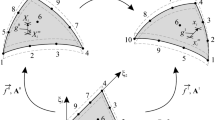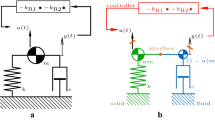Abstract
We propose a non-intrusive numerical coupling method for transient fluid-structure interaction (FSI) problems simulated by means of different discretization methods: smoothed particle hydrodynamics (SPH) and finite element (FE) methods for the fluid and the solid sub-domains, respectively. As a partitioned coupling method, the present algorithm can ensure a zero interface energy during the whole period of numerical simulation, even in the presence of large interface motion. In other words, the time integrations of the two sub-domains (second order Runge–Kutta scheme for fluid and Newmark integrator for solid) are synchronized. Thanks to this energy-conserving feature, one can preserve the minimal order of accuracy in time and the numerical stability of the FSI simulations, which are validated with a 1D and a 2D trivial numerical test cases. Additionally, some other 2D FSI simulations involving large interface motion have also been carried out with the proposed SPH–FE coupling method. Finally, an example of aquaplaning problem is given in order to show the feasibility of such coupling method in multi-dimensional applications with complicated structural geometries.





























Similar content being viewed by others
References
Antoci C (2006) Simulazione numerica dell’interazione fluido-struttura con la tecnica SPH. Ph.D. thesis, Università di Pavia
Antoci C, Gallati M, Sibilla S (2007) Numerical simulation of fluid-structure interfaction by SPH. Comput Struct 85:879–890
Bathe KJ, Zhang H (2009) A mesh adaptivity procedure for CFD and fluid-structure interactions. Comput Struct 87:604–617
Belytschko T, Liu WK, Moran B (2000) Nonlinear finite elements for continua and structures. Wiley, Chichester
Combescure A, Gravouil A (2002) A numerical scheme to couple subdomains with different time-steps for predominantly linear transient analysis. Comput Methods Appl Mech Eng 191:1129–1157
Donea J, Huerta A, Ponthot JP, Rodríguez-Ferran A (2004) Arbitrary Lagrangian–Eulerian methods. Wiley, Chichester
Dubois F (2011) Partial riemann problem, boundary conditions, and gas dynamics. In: Tourrette L, Halpern L (eds) Absorbing boundaries and layers, domain decomposition methods: applications to large scale computations. Nova Science Publishers, Inc, New York, pp 16–77
Farhat C, Crivelli L, Géradin M (1997) On the spectral stability of time integration algorithms for a class of constrained dynamics problems. In: AIAA 34th structural dynamics meeting
Farhat C, Lesoinne M (2000) Two efficient staggered algorithms for the serial and parallel solution of three-dimensional nonlinear transient aeroelastic problems. Comput Methods Appl Mech Eng 182:499–515
Farhat C, Rallu A, Wang K, Belytschko T (2010) Robust and provably second-order explicit-explicit and implicit-explicit staggered time-integrators for highly non-linear compressible fluidstructure interaction problems. Int J Numer Methods Eng 84(1):73–107. doi:10.1002/nme.2883
Felippa CA, Park KC, Farhat C (1998) Partitioned analysis of coupled mechanical systems. Comput Methods Appl Mech Eng 190:3247–3270
Fourey G, Oger G, Touzé Le, Alessandrini B (2010) Violent fluid-structure interaction simulations using a coupled SPH/FEM method. IOP Conf Ser Mater Sci Eng 10:12041
Gingold RA, Monaghan JJ (1977) Smoothed particle hydrodynamics: theory and application to non-spherical stars. Mon Not R Astron Soc 181:375–389
Hughes TJR, Belytschko T (1995) Nonlinear finite element analysis, ICE division. Zace Services Ltd., Lausanne
Idelsohn SR, Marti J, Limache A, Oñate E (2008) Unified Lagrangian formulation for elastic solids and incomressible fluids: application to fluid-structure interaction problems via the PFEM. Comput Methods Appl Mech Eng 197:1762–1776
Leduc J (2010) Étude physique et numérique de l’écoulement dans un système d’injection de turbine Pelton. Ph.D. thesis, École Centrale de Lyon, Ecully
Li Z (2013) Développement d’une méthode de simulation de couplage fluide-structure à l’aide de la méthode SPH. Ph.D. thesis, École Centrale de Lyon, Ecully
Li Z, Combescure A, Leboeuf F (2013) Coupling of finite volume and finite element subdomains using different time integrators. Int J Numer Methods Fluids 72:1286–1306
Li Z, Leduc J, Combescure A, Leboeuf F (2014) Coupling of SPH-ALE method and finite element method for transient fluid-structure interaction. Comput Fluids 103:6–17
Liu GR, Liu MB (2003) Smoothed particle hydrodynamics: a meshless particle method. World Scientific, Singapore
Lucy LB (1977) Numerical approach to testing the fission hypothesis. Astron J 82:1013–1024
Macdonald JR (1966) Some simple isothermal equations of state. Rev Mod Phys 38(4):679–699
Mahjoubi N, Gravouil A, Combescure A (2009) Coupling subdomains with heterogeneous time integrators and incompatible time steps. Comput Mech 44(6):825–843
Mahjoubi N, Gravouil A, Combescure A, Greffet N (2011) A monolithic energy conserving method to couple heterogeneous time integrators with incompatible time steps in structural dynamics. Comput Methods Appl Mech Eng 200(9):1069–1086
Marongiu J.C (2007) Méthode numérique lagrangienne pour la simulation d’écoulements à surface libre—application aux turbines Pelton. Ph.D. thesis, École Centrale de Lyon, Ecully
Marongiu J.C., Leboeuf F, Caro J, Parkinson E (2009) Low mach number numerical schemes for the SPH-ALE method. Application in free surface flows in Pelton turbines. In: 4th SPHERIC workshop, Nantes
Marongiu JC, Leboeuf F, Caro J, Parkinson E (2010) Free surface flows simulations in Pelton turbines using an hybrid SPH-ALE method. J Hydraul Res 48:40–49
Michler C, Hulshoff S, van Brummelen E, de Borst R (2004) A monolithic approach to fluidstructure interaction. Comput Fluids 33(5–6):839–848
Mooney M (1940) A theory of large elastic deformation. J Appl Phys 11:582–592
Newmark NM (1959) A method of computation for structural dynamics. J Eng Mech Div 85(3):67–94
Peskin CS (2002) The immersed boundary method. Acta Numer 11:479–517
Rafiee A, Thiagarajan KP (2009) An SPH projection method for simulating fluid-hypoelastic structure interaction. Comput Methods Appl Mech Eng 198:2785–2795
Schaback R, Wendland H (2006) Kernel techniques: from machine learning to meshless methods. Acta Numer 15:543–639
Scolan YM (2004) Hydroelastic behaviour of a conical shell impacting on a quiescent-free surface of an incompressible liquid. J Sound Vib 277:163–203
Souli M, Ouahsine A, Lewin L (2000) ALE formulation for fluidstructure interaction problems. Comput Methods Appl Mech Eng 190:659–675
Toro EF (2009) Riemann solvers and numerical methods for fluid dynamics. Springer-Verlag, Berlin
Vila JP (1999) On particle weighted methods and smooth particle hydrodynamics. Math Models Methods Appl Sci 9(2):161–209
Walhorn E, Kölke A, Hübner B, Dinkler D (2005) Fluid-structure coupling within a monolithic model involving free surface flows. Comput Struct 83:2100–2111
Zhang L, Gay M (2007) Immersed finite element method for fluid-structure interaction. J Fluids Struct 23:839–857
Zhang L, Gerstenberger A, Wang X, Liu WK (2004) Immersed finite element method. Comput Methods Appl Mech Eng 193:2051–2067
Acknowledgments
This work is partially funded by the “PREDHYMA” European project contract \(\hbox {N}^\circ \) PITN (2013-608393).
Author information
Authors and Affiliations
Corresponding author
Rights and permissions
About this article
Cite this article
Li, Z., Leduc, J., Nunez-Ramirez, J. et al. A non-intrusive partitioned approach to couple smoothed particle hydrodynamics and finite element methods for transient fluid-structure interaction problems with large interface motion. Comput Mech 55, 697–718 (2015). https://doi.org/10.1007/s00466-015-1131-8
Received:
Accepted:
Published:
Issue Date:
DOI: https://doi.org/10.1007/s00466-015-1131-8




